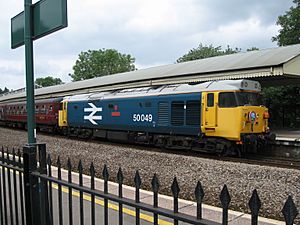British Rail Class 50 facts for kids
Quick facts for kids British Rail Class 50 |
|
 |
|
| 50049 Defiance at Bath Spa Station on 3 June 2007. | |
| Power type | Diesel-electric |
|---|---|
| Builder | English Electric at Vulcan Foundry |
| Build date | 1967–1968 |
| Total production | 50 |
| Configuration | Co-Co |
| UIC classification | Co'Co' |
| Gauge | 4 ft 8 1⁄2 in (1,435 mm) |
| Wheel diameter | 3 ft 7 in (1.092 m) |
| Wheelbase | 56 ft 2 in (17.12 m) |
| Length | 68 ft 6 in (20.88 m) |
| Width | 8 ft 10 in (2.69 m) |
| Height | 12 ft 9 in (3.89 m) |
| Locomotive weight | 115 long tons (117 t) |
| Prime mover | English Electric 16 CSVT |
| Multiple working | ■ Orange Square |
| Top speed | 105 mph (169 km/h) |
| Power output | Engine: 2,700 bhp (2,010 kW) |
| Tractive effort | Maximum: 48,500 lbf (216 kN) Continuous: 33,000 lbf (147,000 N) |
| Train heating | Electric Train Heat |
| Train brakes | Dual (Air and Vacuum) |
| Career | British Rail |
| Number | D400–D449; later 50001–50050 |
| Axle load class | Route availability 6 |
The British Rail Class 50 is a special type of diesel locomotive. These powerful trains were built between 1967 and 1968. They were made by a company called English Electric at their factory in Newton-le-Willows.
Fifty of these locomotives were created. Their main job was to pull fast passenger trains. They worked on a part of the West Coast Main Line that didn't have electric power yet. This route connected places like Crewe, Carlisle, and Scotland.
Meet the Class 50 Locomotives
The Class 50 locomotives were first rented from English Electric Leasings. British Rail (BR) didn't actually buy them until around 1973. Before 1968, these trains had a different name. They were known as the English Electric Type 4 under the old system.
The "Hoover" Nickname
These trains earned a fun nickname: "Hoovers". This name was given to them by train fans. It was because of a very unique sound their engines made. This sound came from special air filters that were first put on the trains.
These filters were supposed to help the engine. However, they didn't work very well and caused problems. So, they were later taken off the trains. Even after the filters were gone, the "Hoover" nickname stuck! It's still how many people remember these distinctive locomotives.
Images for kids
-
50035 Ark Royal at Doncaster Works on 27 July 2003. This locomotive carries BR Blue Large Logo livery, and is preserved on the Severn Valley Railway.
-
50021 Rodney behind 50017 Royal Oak at Tyseley Locomotive Works on 21 November 2004. The latter is painted in non-standard LMS maroon, a legacy from when it was hired to work the VSOE Northern Belle.
-
50019 Ramillies on a ballast working near Hardingham, Mid-Norfolk Railway, June 2009
-
50015 Valiant in Bury, East Lancashire Railway
-
50049 Defiance at Derby in February 2018





















